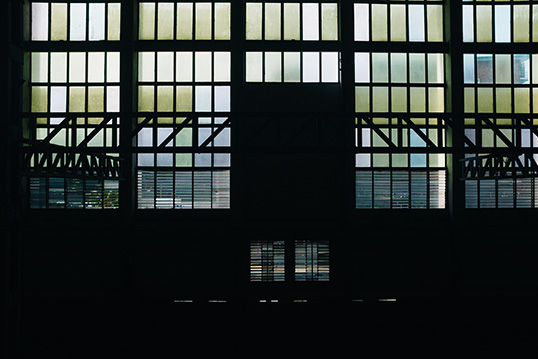She was born in Tokyo on August 10, two years and a day after Nagasaki was blasted, three days after Hiroshima, by the flash of a nuclear bomb.
She emerged from her mother’s womb after ten months and ten days.
She was named Yōko, the yō from Taiheiyō, Japanese for Pacific Ocean.
At six years old, she entered elementary school. Her mother divided her long black hair into thirds and braided it. Out in the Pacific, bright light flashed over the Bikini Atoll. The US was testing bombs, setting them off to see what would happen, atomic first and then hydrogen. A blast of light, a column of water, a mushroom-shaped cloud, out there in the middle of the ocean. The blast washed over a fishing boat, S.S. Lucky Dragon No. 5. Its crew fell ill, and its tuna, now “atomic,” was taken to the Tsukiji fish market only to be buried in the ground.
She sat beside her mother in the darkness of a movie theater and watched the story unfold as a black-and-white newsreel. Her mother was knitting beside her in the darkness, her fingers as nimble with yarn as with her daughter’s hair, and she completed the scarf she was making that very day.
Later that March, the Parliament approved, for the first time since the war, funding for nuclear power. The funding totaled 235 million yen, and production began in earnest to make isotope U-235.
At eleven years old, a year before she entered middle school, Japan issued its first 10,000-yen note. It featured Prince Shōtoku, known in ancient times as the Heavenly-being-from-whence-the-sun-rises. She gazed upon his face, enraptured. Someday I will hold in my hands as many of these as it’s possible to hold, she thought.
At sixteen years old, she was a senior in high school, and Japan produced its first nuclear-generated electricity. Criticality was achieved in a little village called Tōkai, home of the Japan Power Demonstration Reactor. It made the television news, but her family didn’t own a television and she missed it. What she remembers is her middle-school math teacher leaving for Tōkai when her husband got a new job there.
At eighteen years old, she went to a women’s junior college. Student protests over the US-Japan Security Treaty reached their height, but she remained untouched. She graduated with no trouble and looked for a job.
At twenty years old, she got that job, at the Long-Term Credit Bank of Japan. Her hair was no longer divided in thirds and braided—it was short and curled into a permanent wave.
Her wish came true at last: every day, her hands were filled with 10,000-yen notes. They were the bank’s, not hers, of course, but she nonetheless lost herself in their count. These days, machines do the counting, but back then it was done by women sitting at windows in banks.
At thirty years old, having worked for ten years, she married a man who’d quit being a doctor to pursue his dream of becoming a writer. She herself, soon enough, became the mother of four daughters. I should probably mention that the fourth of these daughters was me. For this is the story of my mother.
Nuclear plants sprang up all over Japan. By the time my mother turned forty, thirty-five reactors delivered 27,881,000 kilowatts of electricity to cities across the country. Their streets glowed day and night with nuclear-powered light.
At fifty-one years old, the Long-Term Credit Bank of Japan went under; her daughters, myself included, had all left home for work or marriage. Yukichi Fukuzawa had long since replaced Prince Shōtoku on the 10,000-yen note. The bank stocks she’d bought with her savings became just so much paper.
At sixty-three years old, her husband died, followed by her mother the next year. We all had to buy new clothes for each funeral.
The same year her mother died, an earthquake and tsunami struck Tōhoku. The Fukushima Daiichi Nuclear Power Plant exploded in a blast of light. White clouds rose into the sky in internet videos as invisible radioactive material rained down in real life. Her mother’s death wasn’t due to disaster or radiation, though; it was simply old age. She died at night, on Christmas Day. She left behind an unfinished sweater and hat and some balls of vivid red yarn. Streetlights and neon signs glowed as snow drifted down from the oddly bright Tokyo night sky.
She wore a brand-new, pitch-black mourning dress with her hair pulled back and sunglasses on as she counted the money she owed the funeral parlor. Her hands were filled with 10,000-yen notes. Cataract surgery a few years back had made even indoor light too bright, and she needed dark glasses to see.
Soon after, we all went to a café. In the background, the Glenn Miller Orchestra played “Moonlight Serenade.” I later learned that the song on the original record’s B-side was called “Sunrise Serenade.”
I also learned that as the world’s first nuclear bomb went off at the Trinity Site in New Mexico, the radio played that very song.
The bomb, called “The Gadget,” was 1.5 meters in diameter. The Manhattan Project’s funding totaled two billion dollars. The energy released by the fission of plutonium at its center generated heat reaching 66,000°C, eleven times that of the surface of the sun. Everything touched by its light burned.
At sixty-eight years old, another of her daughters will become a mother.
After ten months and ten days, a baby will emerge from my belly.
And as it slowly opens its eyes, will it look into the light of the sun?

